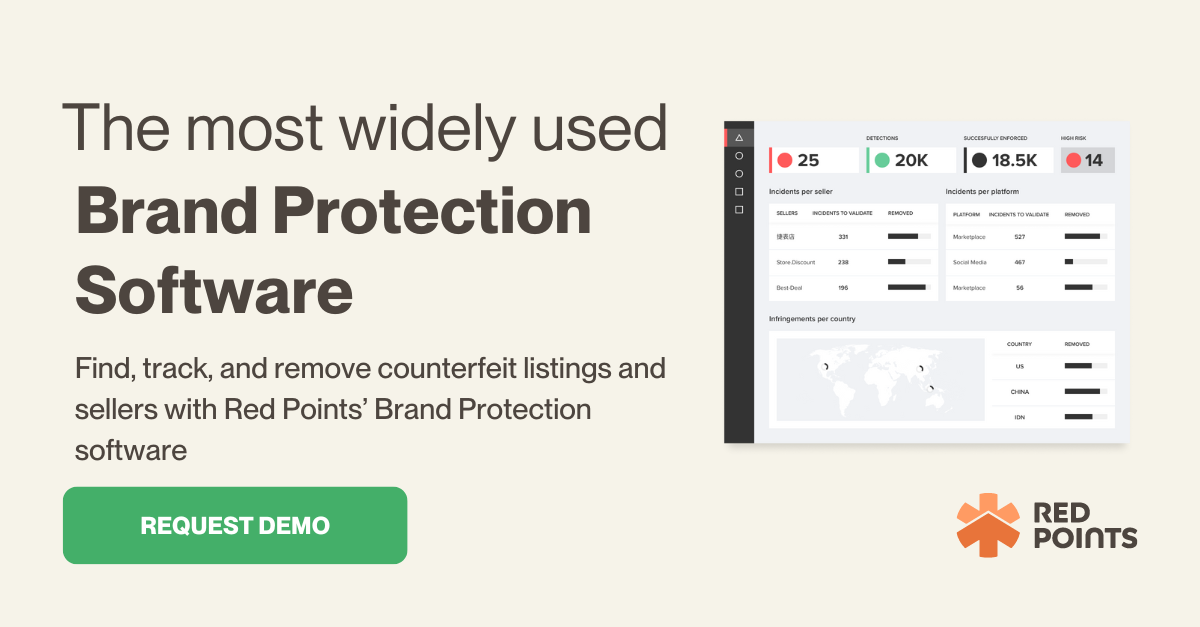Counterfeiting isn’t a new problem. In fact, the companies selling fake goods have been around for about as long as the real ones. Counterfeiters’ ability to adapt to changing consumer behavior and ever-evolving anti-counterfeiting measures has seen them grow tremendously over the years. The International Chamber of Commerce estimates that the global economic value of counterfeiting and piracy could reach $4.2 trillion by 2022 and put 5.4 million legitimate jobs at risk over that time period.
Summary:
- New ways counterfeiters are selling fake wares online
- Limitations of current brand protection best practices
- A new technological approach to tackling ever-evolving counterfeits
As right holders, businesses have both the right and responsibility to remove fake products from online platforms. Beyond the obvious reputational damages counterfeit products can have on a business, in some cases, it can pose an even greater threat to customers’ health and safety. Over the years, counterfeiters have evolved rapidly, making it a priority for brands to stay on top of the latest industry and technological trends in order to safeguard their consumers and revenue.
Here are the top three ways counterfeiters currently exploit the internet to lure consumers into buying their goods.
- They offer presumed “high quality” products. Far from the common belief, counterfeiters are increasingly moving away from offering rough copies. Their replicas are getting closer and closer to the original look and feel of branded products. To make matters worse, their production is very agile which allows them to copy a new product as soon as it is officially launched.
- They leverage marketing tools. Instead of using the brand’s official pictures, bad actors are now taking their own. Often time, using high resolution and quality images to make it less suspicious for potential buyers. In some instances, these pictures even include elements from the original manufacturer e.g. logos or iconic visual elements. In other words, they create their own anonymous branding.
- They work within large-scale counterfeit networks. We found that in many cases counterfeiters operate at a larger scale in big networks, promoting multiple listings across a wide range of marketplaces and social media networks. To streamline the process, they often use the same content from several accounts in order to ensure their revenue stream isn’t cut all at once.
Example of an avatar being used by a reseller network as identification and quality sign
Best practices aren’t always best
When it comes to handling some of these new counterfeiters’ tactics to sell fakes online, current methods have their limitations
- Search algorithms as a standalone aren’t efficient enough to detect these types of infringements. The technologies used are sometimes reduced to an extensive keyword search. Without the use of machine learning, this limits the results to easily visible infringements. At best, these algorithms are able to identify a part of the listings, which fails to provide a full picture. Also, by using keyword search only, it’s not possible to connect the dots and prioritize the main targets to investigate.
- Current image searches do not detect listings that don’t use a set of predefined images. In some industries, this technology remains very useful, however as we’ve seen previously, the rise of high-quality self-generated images from counterfeiters means some listings still remain undetected.
Having said that, currently many companies and providers tend to focus on combining these technologies, and complement them with a team of analysts doing manual searches. Depending on what metrics you look at, results can seem good at first. But this is not a scalable method. Over time, it will prove time-consuming and not very effective compared to the capacity of counterfeiters. Plus, this method doesn’t support building strategies to cut infringements at the source and gather information.
The solution
Often the easiest answer to a problem is the hardest to achieve. This case is no exception. To identify infringing listings, the “easy” answer is to leverage image recognition to detect a product from any image.
This means a technology able to analyze thousands of pictures every day across marketplaces and social media, and that could be trained to detect any type of protected products. At Red Points, our approach to leveraging technology to tackle this problem is actually rather straightforward:
- We leverage image recognition to detect infringements: This means no matter the type of pictures used, how often they are changed or from which angle they were taken, we will detect if the product is inside the image. This means automating a task that would otherwise be impossible to do manually. Needless to say that the volume of listings covered and time to detection compared to a manual or semi-manual investigation is significantly reduced.
- We use ‘known bad images’ tech to automate the takedown process. For instance, if image search isn’t useful in the scenario we’re looking at, we can use counterfeiters’ self- taken images to automatically confirm an infringement.
- We offer clustering technology to identify counterfeiters using several platforms: Having a way to detect all IP infringements only solves one part of the problem. One other important component is to connect the dots, and reveal counterfeiters’ identities. To do so, our platform automatically matches seller information from different marketplaces and social media sites to prioritize the bigger infringers and focus their efforts leveraging opensource.
Conclusion
It goes without saying that counterfeiters will continue to evolve and what works today won’t be suited for tomorrow. Given the speed at which online counterfeits spread online, dealing with copycats manually will quickly feel like fighting a losing battle. Enlisting the help of a technology partner to join the dots between listings across all major marketplaces to speed up Intellectual Property monitoring procedures will come a long way to help you reach your wider company goals.






